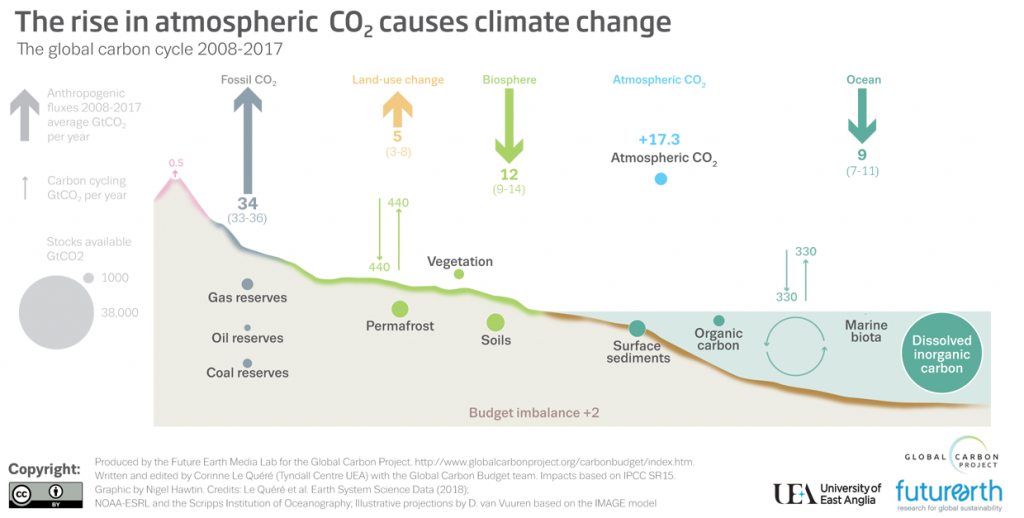
AFFIRMATION COMPLETE: Discovery Of Massive Volcanic CO2 Emissions Discredits Global Warming Theory [...] All indications are that Earth is currently experiencing another period of strong volcanic activity which is acting to infuse CO2 into our atmosphere thereby challenging the validity of the global warming theory.
Carbon dioxide is released into the atmosphere by volcanic eruptions—as well as by passive venting around volcanoes that are not erupting. The amount of CO2 emitted varies from one volcanic feature to another, and varies with time, which makes quantifying global emissions a challenge. However, there are multiple ways of constraining their contribution.
The most recent estimate1 puts total global emissions from all volcanic activity at approximately 280 million to 360 million metric tons of CO2 per year. Of this, active eruptions only account for about 2 million metric tons per year. Additionally, there is no evidence that volcanic activity has increased over the last century, while atmospheric CO2 has increased significantly.
Human-caused CO2 emissions are much larger than this estimate. Current emissions from fossil fuel burning, industrial processes, and land use change (like deforestation) equal about 39 billion metric tons per year2—at least 100 times greater than the amount released by all volcanic activity, let alone eruptions.
Prior to human-caused emissions, Earth’s carbon cycle was in balance. The amount of CO2 released by things like volcanoes, wildfires, and respiration by living things was equal to the amount of atmospheric CO2 taken up by processes like bedrock weathering and photosynthesis. Human-caused emissions are not matched by a human-caused process of CO2 uptake, so this net addition is responsible for the observed increase in atmospheric CO2 since the Industrial Revolution.
In addition to these accounting methods for estimating the factors related to the atmospheric CO2 concentration, the source of the CO2 added to the atmosphere can also be determined from the isotopes of carbon in the air. Contrary to the claim in the article, the carbon atoms in volcanic CO2 do have a different isotope ratio than the carbon atoms in fossil fuel CO2. In fact, the very source the article links to support its claim actually explains this. The measured change in atmospheric carbon-14, carbon-13, and carbon-12 shows that the CO2 added to the atmosphere has come from fossil fuel burning and deforestation—not volcanoes or other sources3.
- 1- Werner et al (2019) Carbon Dioxide Emissions from Subaerial Volcanic Regions (in Deep Carbon, Past to Present)
- 2- Le Quéré et al (2018) Global Carbon Budget 2018, Earth System Science Data
- 3- Rubino et al (2013) A revised 1000 year atmospheric δ13C‐CO2 record from Law Dome and South Pole, Antarctica, Journal of Geophysical Research: Atmospheres
The contribution of volcanoes to the global carbon dioxide (CO2) emissions budget is small1-16 compared to the emission from burning of fossil fuels17. In detail, the contribution of volcanic eruptions can be illustrated by considering recent, well-studied large eruptions, such as the 2014 Holhuraun eruption in Iceland.
The massive Holhuraun eruption emitted a cumulative amount of 9,330 kilotons of CO2 (or 9.3 x1012 g CO2)18. The eruption of Etna Volcano in Italy in the year 2006 emitted a cumulative CO2 amount of 644 kilotons (or 0.644 x 1012 g CO2). Another recent and massive eruption was the 2010 Eyjaflallajokul eruption in Iceland that emitted a cumulative amount of CO2 of 5,130 kilotons (or 5.1 x 1012 g CO2)18. While these eruptions have significantly affected local air travel and disrupted the daily lives of the population living in the region, the amount of CO2 emitted is dwarfed by the emissions resulting from human activities.
The burning of fossil fuels and production of cement has released 36.3 gigatons of CO2 (or 36,300 x 1012 g CO2) into the atmosphere in 201517. Therefore, the largest CO2 emitting eruption in the past 15 years (Holhuraun in 2014) produced only about 0.026% of the yearly anthropogenic emissions. Indeed, we would need to have about 3,890 such massive eruptions like Holhuraun in one year to produce the equivalent of CO2 emitted due to fossil fuel burning and cement production. This number would require an eruption like Holuhraun 2014 to occur about 10 times per year or about once per month. However, such large CO2 emitting eruptions are rare and the Holuhraun 2014 eruption is unique in the past 15 years18.
The total CO2 emissions for volcanic eruptions for the time frame from 2005 to 2018 was 26.9 megatons (or 26.0 x 1012 g CO2) and, therefore, in an average year only about 2,070 kilotons of CO2 (or 2.0 x 1012 g) are produced from volcanic eruptions18. This means that, during a typical year, volcanic eruptions contribute only about 0.006% of the global anthropogenic CO2 flux. The average CO2 emission of a person living in the USA is about 16 tons of CO2 per year17. Therefore, in any given year volcanic eruptions produce only about as much CO2 as 130,000 Americans, or less than the population of Wyoming—the state with the lowest population in the US.
- 1- Aiuppa et al (2019) CO2 flux emissions from the Earth’s most actively degassing volcanoes, 2005–2015, Scientific Reports
- 2- Allard (1992) Global Emissions of helium-3 by subareal volcanism, Geophysical Research Letters
- 3- Brantley and Koepenick (1995) Measured carbon dioxide emissions from Oldoinyo Lengai and the skewed distribution of passive volcanic fluxes, Geology
- 4- Burton et al (2013) Deep carbon emissions from volcanoes, Reviews in Mineralogy and Geochemistry: Carbon in Earth
- 5- Fischer (2008) Volatile fluxes (H2O, CO2, N2, HCl, HF) from arc volcanoes , Geochemical Journal
- 6- Gerlach (1991) Present-day CO2 emissions from volcanoes, EOS Transactions
- 7- Hilton et al (2002) Noble gases in subduction zones and volatile recycling, MSA Special Volume: Noble Gases in Geochemistry and Cosmochemistry
- 8- Kerrick (2001) Present and past nonanthropogenic CO2 degassing from the solid earth, Reviews of Geophysics
- 9- Le Guern (1982) Les debits de CO2 et de SO2 volcaniques dans l’atmosphere. Translated title: Discharges of volcanic CO2 and SO2 in the atmosphere, Bulletin of Volcanology
- 10- Williams et al (1992) Global carbon dioxide emission to the atmosphere by volcanoes, Geochimica et Cosmochimica Acta
- 11- Marty et al (1989) Helium isotopes and CO2 in volcanic gases of Japan, Chemical Geology
- 12- Marty and LeCloarec (1992) Helium-3 and CO2 fluxes from subaereal volcanoes estimated from Polonium-20 emissions, Journal of Volcanology and Geothermal Research
- 13- Marty and Tolstikhin (1998) CO2 fluxes from mid-ocean ridges, arcs and plumes, Chemical Geology
- 14- Moerner and G. Etiope (2002) Carbon degassing from the lithosphere, Global and Planetary Change
- 15- Sano and Williams (1996) Fluxes of mantle and subducted carbon along convergent plate boundaries, Geophysical Research Letters
- 16- Shinohara (2013) Volatile fluxes from subduction zone volcanoes: insights from a detailed evaluation of the fluxes from volcanoes in Japan, Journal of Volcanology and Geothermal Research
- 17- Le Quéré et al (2016), Global Carbon Budget 2016, Earth System Science Data
- 18- Werner et al (2019) Carbon Dioxide Emissions from Subaerial Volcanic Regions (in Deep Carbon, Past to Present)




